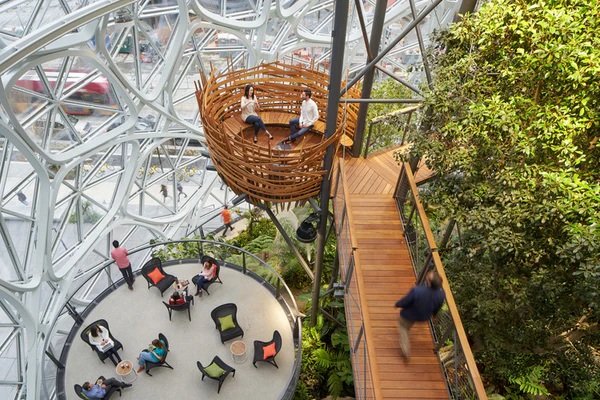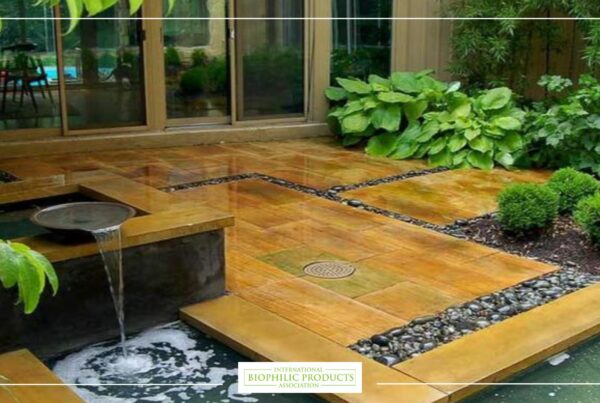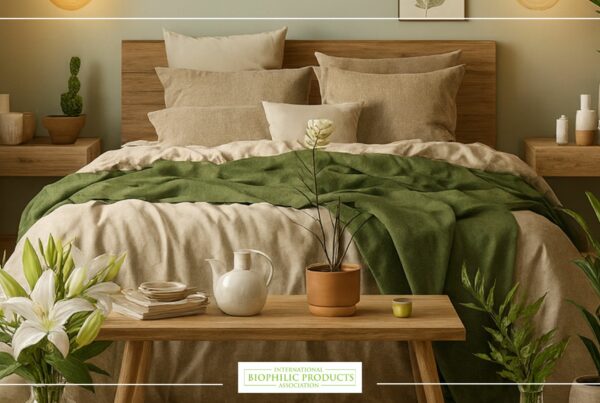Modern life keeps most of us indoors, hunched over screens and surrounded by synthetic materials. The result? Chronic stress, cognitive fatigue and an epidemic of mental‑health issues.
A simple antidote is available outside our front door: nature. Spending just ten minutes in a natural setting can noticeably lower stress hormones and heart rate. If you don’t have easy access to greenery, bringing natural elements inside through biophilic design can offer similar benefits even in dense cities. This article explores the science behind short nature breaks, explains why we’re wired to crave the outdoors, and offers practical tips for incorporating biophilia into your everyday life.

Biophilia: our deep‑seeded connection with nature
The term biophilia refers to the idea that humans have an innate desire to connect with other forms of life. Psychologist Erich Fromm and biologist E.O. Wilson popularised the concept, suggesting that this urge is woven into our genes. Biophilia explains why a hike in the forest clears your mind, why a desk plant lifts your mood, and why children are fascinated by bugs and puddles. It’s more than a romantic notion; research links nature connectedness with tangible physiological and psychological benefits:
- A scoping review of studies on college students found that when participants spent as little as 10 minutes sitting or walking in a variety of natural settings they experienced significant improvements in psychological and physiological markers of well‑being. In other words, brief exposure to green space measurably reduces stress.
- Visual connections with nature, through views, plants or natural materials, can lower blood pressure and heart rate, improve mental engagement and attentiveness, and boost overall happiness. Plants in the office have been linked to a 47 % increase in well‑being and a 38 % boost in productivity.
- A comprehensive report on biophilic design concludes that integrating nature into buildings reduces stress, enhances creativity and clarity of thought, improves well‑being and expedites healing.
These findings support what our bodies and minds already tell us: we need nature. Unfortunately, urbanization and indoor lifestyles keep us from satisfying that need. That’s where short “nature pills” and biophilic design come in.
Research shows that 10 minutes in nature reduces stress markers
The 10‑minute dose of nature

A team from Cornell University reviewed existing studies to determine how much time college‑age students need in nature to experience a measurable benefit. They discovered that just 10 minutes in a natural setting helps students feel happier and reduces the effects of both physical and mental stress. The researchers found that spending 10–50 minutes sitting or walking outdoors was most effective for improving mood, focus and physiological markers like blood pressure and heart rate. These results mean you don’t need a weekend in the wilderness to reset, ten minutes on a tree‑lined path or park bench is enough to quiet your nervous system.
The Cornell team’s findings echo those of a broader review published in Frontiers in Psychology. The authors screened thousands of titles and narrowed them to 14 studies involving college students. They concluded that as little as 10 minutes of sitting or walking in diverse natural settings significantly and positively impacted defined psychological and physiological markers of mental well‑being. When compared with equal time spent in urbanized environments, the natural settings consistently produced greater reductions in stress and improvements in mood.
The “nature pill” experiment
Researchers at the University of Michigan took the idea further with a so‑called nature pill study. Participants were instructed to spend 10 minutes or more in a place they felt connected to nature at least three times a week for eight weeks. They could choose any outdoor space—yards, parks or green areas near work—and were asked to avoid phones, conversations and reading during their natural time. The team measured salivary cortisol, a stress hormone, before and after each session. The results were striking:
- A 20‑minute nature experience was enough to cause a significant drop in cortisol levels.
- The largest reduction in cortisol occurred when participants spent 20–30 minutes sitting or walking in a natural environment. After half an hour, additional de‑stress benefits continued to accumulate but at a slower rate.
- Participants were free to choose the location and time of day, demonstrating that flexible, self‑directed nature exposure is still effective.
Similarly, a study highlighted by Harvard Health Publishing asked 36 volunteers to spend 10 minutes or more in an outdoor setting three times a week for eight weeks. Spending 20–30 minutes immersed in nature produced the biggest drop in cortisol levels. After that, the stress‑reduction benefits levelled of health. The take‑home message: a short daily dose of nature is both realistic and powerful.
Why nature calms us: the science behind stress recovery
Two main theories explain why natural environments reduce stress: attention Restoration Theory (ART) and Stress Reduction Theory (SRT). ART posits that directed attention is a limited resource; our device‑heavy lives exhaust it, leading to irritability and mental fatigue. Natural settings engage our attention effortlessly through soft fascinations—rustling leaves, cloud formations—allowing the brain to recover. SRT goes a step further, suggesting that natural stimuli trigger our parasympathetic nervous system (the “rest and digest” branch) to override the fight‑or‑flight response. Researchers experimenting with immersive biophilic environments found that viewing natural elements can activate the parasympathetic system, resulting in lower heart rate, blood pressure, skin conductance and salivary cortisol levels. These physiological changes promote relaxation and reduce autonomic arousal.
Evolution likely plays a role. Humans spent most of their history outdoors; only recently have we shifted to spending 90 % of our time indoors. Our nervous system still interprets natural cues,plants, water, sunlight, as signals of safety and abundance. When deprived of these cues, we remain in a heightened state of alertness. Ten minutes under a tree resets this ancient program.
Biophilic design: bringing nature indoors
What is biophilic design?
Biophilic design applies the principles of biophilia to architecture and interior design. Instead of isolating us from the outside world, it integrates natural elements, plants, water features, daylight, fresh air, organic materials and patterns, into the built environment. Researchers organize biophilic design strategies into three categories:
- Nature in the space: direct presence of nature (living plants, water, animals, natural light and air). Examples include indoor gardens, green walls, aquariums and operable windows.
- Nature of the space: mimicking natural spatial characteristics, such as prospect and refuge, variations in height and depth, or creating cozy niches that feel like safe havens.
- Natural analogues: using materials, textures, colors and patterns that reference nature—wood grain, stone, fractal patterns and biomorphic shapes.
A seminal report from Terrapin Bright Green stresses that biophilic design can reduce stress, enhance creativity and clarity of thought, improve well‑being and expedite healing. Simply put, when our homes and workplaces echo the natural world, we feel and perform better.
Evidence that biophilic design reduces stress and enhances well‑being
The benefits of bringing nature indoors are not just theoretical:
- The gatherit.co guide on biophilic design notes that a visual connection with nature lowers blood pressure and heart rate, improves mental engagement and attentiveness and is linked to reduced depression, heart disease and diabetes. Even indoor plants can boost well‑being by nearly 47 % and creativity by 45 %.
- A healthy dwelling viewpoint article summarises research showing that nature connectedness leads to relaxation, stress relief, lower blood pressure and heart rate, decreased chronic pain, improved cognitive functioning and increased positive emotions. These benefits apply to residential spaces, workplaces and healthcare facilities.
- In an immersive virtual‑reality experiment, researchers found that natural elements activated the parasympathetic nervous system and produced lower heart rate, blood pressure, skin conductance and salivary cortisol. This supports the idea that simply viewing nature, even digitally, can calm our physiology.
- A collaboration between Stantec and Harvard’s T.H. Chan School of Public Health measured blood pressure, heart rate, heart‑rate variability and skin conductance in participants experiencing different levels of biophilic design in office environments. Participants in spaces with natural elements had consistently lower physiological stress indicators and higher creativity scores, and the largest reductions in blood pressure and heart rate occurred when natural elements were present.
These findings demonstrate that biophilic design and mental health are intrinsically linked. Integrating greenery, natural light and organic materials into our buildings isn’t just aesthetic; it’s a health intervention.
Practical ways to practice biophilic design
You don’t need to renovate your entire home or office to reap the benefits of biophilic design. Small changes can make a big difference:
- Add plants: place potted plants on your desk, shelves and windowsills. Consider a living wall or a small herb garden in the kitchen. Studies show that houseplants and flowers improve relaxation and reduce stress.
- Maximize natural light: move furniture to allow sunlight into rooms. Install mirrors to bounce light deeper into your space. Use sheer curtains instead of blackout drapes during the day.
- Use natural materials: choose wood, stone, bamboo and wool over plastics and synthetics. Surfaces showing natural grain can relax the autonomic nervous system.
- Incorporate water features: a tabletop fountain, aquarium or even the sound of trickling water can increase tranquility and lower heart rate.
- Create prospect and refuge: arrange furniture to provide open views (prospect) while also offering cozy nooks (refuge). A reading corner with a high‑back chair and surrounding plants feels safe and calming.
- Use fractal patterns and biomorphic forms: rugs, wallpapers or artwork featuring organic, repeating patterns mimic natural textures and may subconsciously reduce stress.
- Bring in fresh air: open windows when possible to increase airflow variability, which can enhance concentration. Use natural scents like lavender or forest‑bathing diffusers to promote relaxation.
Biophilic design and mental health
Chronic stress is linked to anxiety disorders, depression and a host of physical illnesses. Biophilic design offers a non‑pharmacological way to mitigate these issues. The healthy dwelling article notes that biophilic interventions can improve relaxation, reduce stress and depressive symptoms, and provide pain relief. For individuals living with migraines, chronic pain or depression, integrating plants, dynamic lighting, soundscapes and spaces for meditation into the home can create a therapeutic environment. These same principles apply to workplace and educational settings, where supportive environments can help students and employees manage stress and maintain well‑being.
Mental health benefits extend beyond lowering cortisol and heart rate. Access to natural elements improves mood, increases feelings of vitality and fosters a sense of connectedness that counters loneliness. The Stantec/Harvard study mentioned earlier found that exposure to green plants and biomorphic patterns not only reduced physiological stress but also boosted creativity and cognitive performance. In healthcare settings, patients with a view of nature recover faster and require less pain medication; this classic finding inspired decades of research into healing environments.
Nature in dense cities: strategies for urban dwellers
Not everyone has a backyard or a park nearby. Urban residents often face concrete landscapes with limited green space. Thankfully, the research shows that even brief interactions with nature or natural elements can provide significant benefits. Here are strategies for city dwellers:
- Micro‑breaks outside: find nearby street trees, pocket parks or rooftop gardens. Take a 10‑minute walk or sit on a bench during your lunch break. Even a planter with flowers can serve as your nature does.
- Window views: position your desk to face a window with a view of trees or sky. If that’s not possible, hang large nature photographs or use digital screensavers showing forests or ocean scenes.
- Community gardens and parks: volunteer at a community garden or join a local green initiative. Shared gardens provide access to greenery and social connections.
- Portable nature: carry nature with you, small potted plants, a sprig of herbs or essential oils. Even listening to birdsong or natural sounds through headphones can evoke relaxation.
- Biophilic public spaces: advocate for green roofs, living walls and tree‑lined streets in your community. Urban planners are increasingly adopting biophilic principles to combat heat islands and improve public health.
Remember, the key is regularity. Scheduling short nature breaks into your daily routine helps maintain lower stress levels and supports mental health.
Making biophilia a lifestyle
Combining nature exposure with biophilic design creates a powerful synergy. Here’s how to weave biophilia into your lifestyle:
- Schedule daily nature time: pencil a 10–30 minute outdoor break into your calendar as you would any appointment. Protect it from digital distractions, leave your phone behind or put it on airplane mode.
- Transform your space: start with one room, maybe your home office or bedroom, and integrate plants, natural materials and good daylight. Observe how your mood and productivity change.
- Practice mindfulness in nature: during your nature time, pay attention to sensory details: the texture of bark, the smell of soil, the pattern of leaves. This focus enhances the restorative effect.
- Share the experience: encourage colleagues, friends and family to join you on short nature walks or help you build a green workspace. Collective commitment increases the likelihood of sticking with the habit.
- Educate others: if you manage a team or own a business, consider implementing biophilic design principles in your workspace. The payoff can be improved employee well‑being, creativity and productivity.
A small dose with big benefits
In our fast‑paced, screen‑dominated world, stress can feel inevitable. Research from Frontiers in Psychology, Cornell University and Harvard shows that just 10 minutes in nature can reduce stress markers like heart rate and cortisol, improve mood and sharpen focus. Longer sessions of 20–30 minutes yield even greater declines in cortisol but return diminishing benefits after half an hour. When natural landscapes aren’t available, biophilic design, incorporating plants, natural light, water and organic materials indoors, provides a daily dose of calm and supports mental health.
The evidence is clear: embracing our biophilic instincts isn’t a luxury but a necessity for well‑being and mental health. So step outside, bring a bit of nature in, and feel your stress melt away, sometimes ten minutes is all it takes.











13 Comments